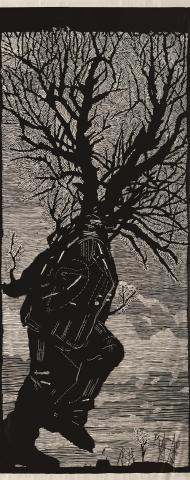WALKING MAN, 2000
WILLIAM KENTRIDGE
linocut on paper
251.0 x 101.0 cm
signed and numbered below image
edition: 11/25
Annandale Galleries, Sydney
Private collection, Sydney
Impressions from South Africa 1965 to Now, The Museum of Modern Art, New York, 23 March – 29 August 2011 (another example)
Hecker, J., William Kentridge – Trace: Prints from the Museum of Modern Art, Museum of Modern Art, New York, 2010, pl. 13 (illus., another example)
Hecker, J., Impressions from South Africa: 1965 to Now, Museum of Modern Art, New York, 2011, p. 28, (illus., another example)
Krauss, R., Malbert, R., and McCrickard, K., A Universal Archive: Kentridge as Printmaker, Hayward Gallery, London, 2012, p. 65 (illus., another example)
McCrickard, K., William Kentridge, Tate Publishing, London, 2012
One of the most sought after international artists working today is South African artist and theatre director, William Kentridge. His survey exhibitions are highlights of the exhibition calendars in major museums around the world and are a tour de force of artistic expression. His 2004 survey exhibition held at the MCA in Sydney was one of the most popular and widely acclaimed exhibitions held there to date and he was also the star of the 2008 Biennale of Sydney.
Born in South Africa in 1955, Kentridge grew up during the apartheid regime. Both his parents were lawyers who were active in the antiapartheid movement, so it is not surprising that events of that period underpin much of Kentridge's ideas and work. Once restrictions on freedom of expression in South Africa were lifted in 1994, he let fly with both barrels.
In 2009, he declared: 'Everything is provisional in my art: there are no absolutes, no answers. I'm just trying to say: 'Wake up and look what is going on around you'. From political oppression to democracy, South Africa has provided me with an important lens through which to understand the world ' but every society is unbalanced and in need of redress. We should never take our place in the world for granted.'1
Film, stage production, opera, animation, sculpture, printmaking and particularly drawing are all part of Kentridge's armoury. It is rare for an artist's work to span such a range of artistic disciplines with the strident confidence that Kentridge's work achieves. After his beginnings working in theatre, the stage was set for a career that is staggering in its breadth and complexity.
As an artist, Kentridge trusts his intuition. In a recent film documentary for PBS television series Arts21, Kentridge stated that as an artist he cannot always be sure where a work will take him, but that if he follows it, and trusts that there is some intellectual power at play, that will draw out the image.
'In collaboration with a specialised printmaking workshop, Kentridge created this monumental linocut using a large panel of linoleum flooring. Because it is inexpensive and easy to print, linoleum is widely used in community-based printmaking workshops in South Africa. Expressive black-and-white printing is characteristic of the medium.'2
This major work was part of a landmark series in multiple mediums created between 1989 and 2002 under the umbrella title of Ubu and the Procession'. These works explored the impact of South Africa's Truth and Reconciliation Commission hearings.
'The procession - a stream of figures weighed down by possessions - is a recurring motif in Kentridge's work, appearing in animated films, drawings, collages, prints and a book. Informed by archival material and the artist's own creative process, this motif relates to conditions in South Africa and evokes more generally the many states of migration and displacement around the world.'3
William Kentridge has firmly established himself as one of the most diverse and important international contemporary artists.
1. William Kentridge, Universal Archive (Parts 7-23), Annandale Galleries, Sydney, 2012, p. 69
2. MOMA, New York, Exhibition Website: William Kentridge Five Themes 2010 - Occasional and Residual Hope: Ubu and the Procession 1989-2002 (http://www.moma.org/interactives/ exhibitions/2010/williamkentridge/flash/)
3. Ibid.
HENRY MULHOLLAND
